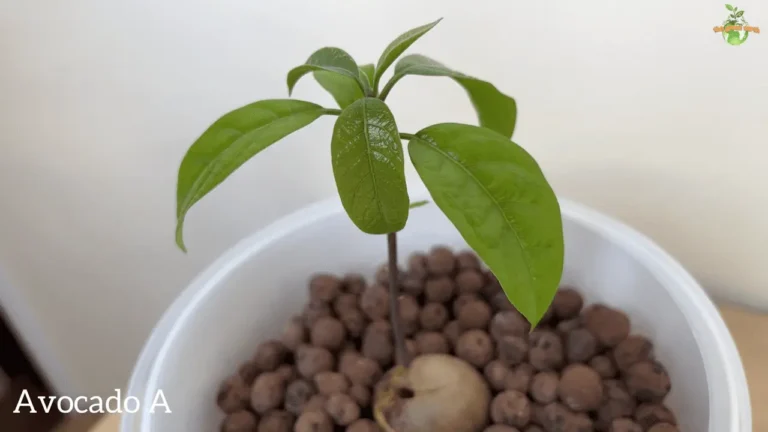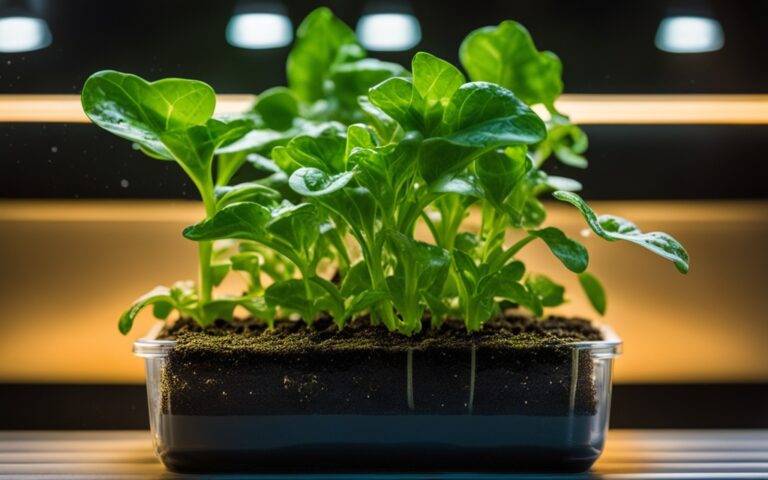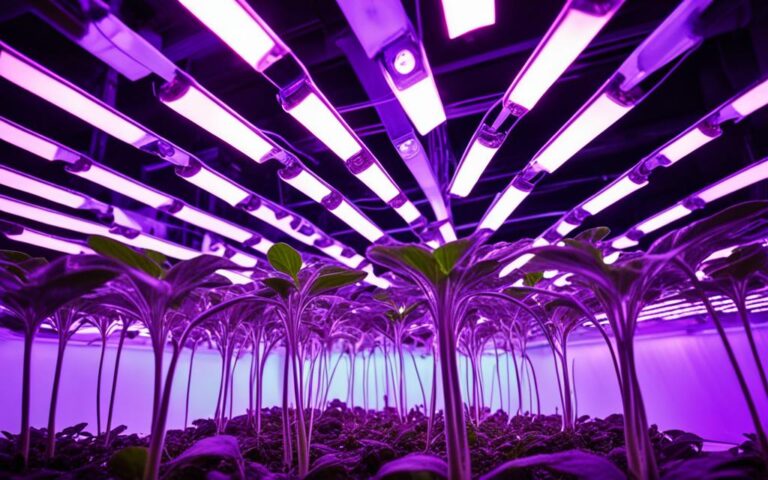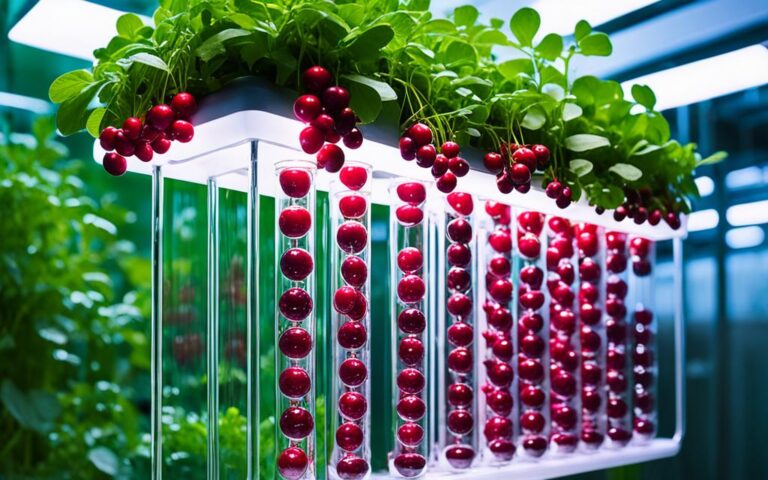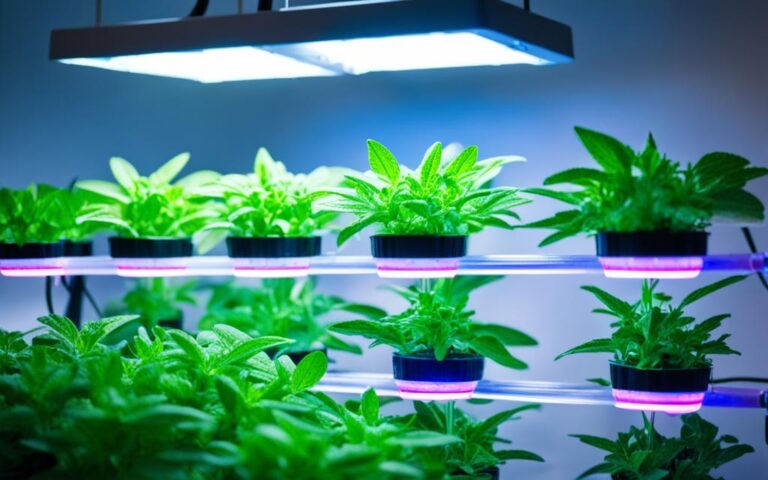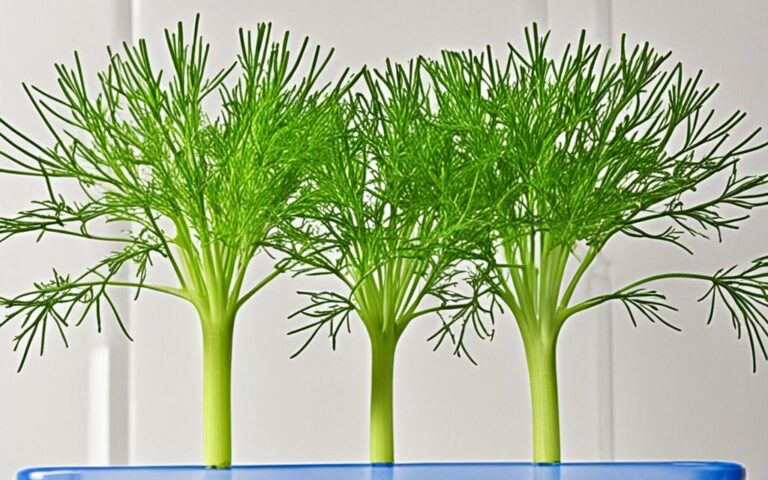Growing Fresh Hydroponic Mint at Home
Did you know you can grow hydroponic mint all year, even in tiny spaces? This new way of growing plants doesn’t use soil. It’s a green way to get fresh mint without the usual gardening work. It’s perfect for city folks or gardening pros alike.
Key Takeaways
- Hydroponic mint thrives indoors with minimal space requirements
- Mint can be grown year-round, providing a steady supply of fresh, flavorful leaves
- Hydroponic systems offer a sustainable, soil-less alternative to traditional gardening
- Mint is a versatile herb with numerous culinary and medicinal uses
- Growing mint hydroponically is a rewarding hobby for both novice and experienced gardeners
What is Hydroponic Mint?
Mint is a versatile herb that does well in hydroponic systems. It adds a captivating aroma to teas, desserts, cocktails, garnishes, and sauces. In ancient Greece and the Middle East, mint was seen as a symbol of hospitality. It was given to guests.
There are hundreds of mint types, but peppermint and spearmint are most well-known. Peppermint is sweet and great for desserts and drinks. Spearmint is savory and often used in cooking.
Introduction to Hydroponic Mint Cultivation
Peppermint is loved for its sweet taste and is used in many desserts and drinks. Spearmint is a favorite spice for cooking. Hydroponic mint also keeps pests like spider mites, aphids, and whiteflies away. This makes it great for indoor gardens.
Benefits of Growing Mint Hydroponically
- Consistent, year-round availability of fresh mint
- Increased yield and faster growth compared to soil-based cultivation
- Reduced risk of pests and diseases due to the controlled hydroponic environment
- Efficient use of space, making it ideal for small-scale or urban gardens
- Ability to precisely control nutrient, water, and environmental conditions for optimal plant health
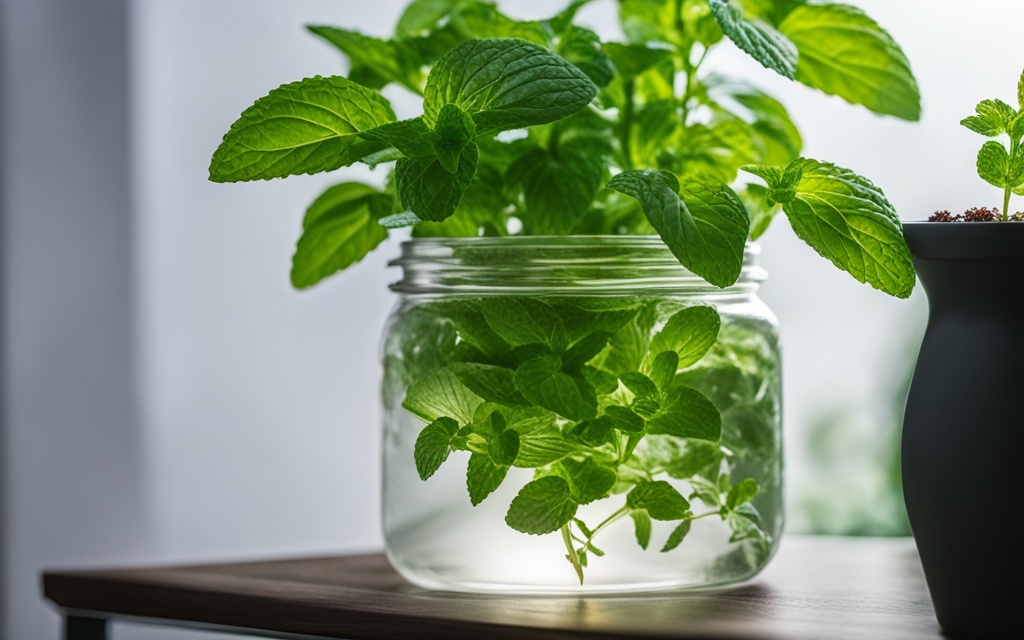
“Mint has been used as a symbol of hospitality in ancient Greece and the Middle East, where it was offered to guests.”
| Mint Variety | Flavor Profile | Culinary Uses |
|---|---|---|
| Peppermint | Sweet | Desserts, syrups, refreshing drinks |
| Spearmint | Savory | Cooking, spice mixes |
Selecting the Right Mint Variety
Choosing the right mint variety is key when growing mint hydroponically. The type of mint you pick can greatly affect the final product. You should pick based on how you plan to use the herbs.
We’ve had great success with peppermint and spearmint in our hydroponic gardens. Peppermint is sweet and refreshing, perfect for desserts, syrups, and drinks. Spearmint has a savory taste, great for many dishes, from garnishes to spice blends.
| Mint Variety | Flavor Profile | Ideal Uses |
|---|---|---|
| Peppermint | Sweet, refreshing | Desserts, syrups, drinks |
| Spearmint | Savory | Cooking, garnishes, spice blends |
When choosing mint for your hydroponic garden, think about the flavors you like and the dishes you’ll use the herbs in. Try out different types of mint for hydroponics to find the best mint varieties for hydroponics for you.
Germinating Hydroponic Mint
Starting a hydroponic mint garden begins with germination. You can start with mint seeds or clone existing plants. Knowing how to do this is crucial for growing healthy, tasty mint at home.
Starting from Seeds
Mint seeds are small but can grow into beautiful plants with care. Don’t plant too many seeds as they can grow too close together. Try planting 2-3 seeds per container and remove the weaker ones later.
Be patient when germinating hydroponic mint from seeds. It might take up to two weeks for them to sprout. Keep the seeds moist and warm, and they will grow well in your hydroponic setup.
Cloning Existing Mint Plants
For a quicker start, try cloning mint plants hydroponically. This way, you can make new plants from cuttings of a healthy mint plant. The paper towel method works well for this, helping seeds germinate faster and root quicker.
Learning about starting seeds and cloning can help you grow a successful hydroponic mint garden. With patience and careful attention, your germinating hydroponic mint will flourish. You’ll have a steady supply of fresh, tasty mint leaves.
Setting Up Your Hydroponic System
Growing fresh, aromatic mint at home with a hydroponic system is easy. Mint is a tough plant that does well in many best hydroponic systems for mint. You can pick from simple bubble buckets to complex setups like NFT and ebb and flow. Just make sure the system fits your space, budget, and hydroponic skills.
Choosing the Right Hydroponic System
Mint spreads out, so think about its growth when picking a hydroponic equipment for growing mint. Give each mint plant about 9-12 inches of space for many harvests. You can do this in setups like:
- Small bubble buckets or containers
- Nutrient film technique (NFT) channels
- Ebb and flow (flood and drain) systems
Your choice should match your space, budget, and what you like when setting up a hydroponic mint garden.
Components and Equipment Needed
No matter the best hydroponic systems for mint you pick, you’ll need these key parts for your hydroponic mint garden:
- Growing container or channels
- Grow media (like coco coir or hydroton)
- Nutrient solution and delivery system
- Air pump and air stones (for aeration)
- Water pump and tubing (for circulation)
- Lighting system (if growing indoors)
With the right hydroponic equipment for growing mint and some planning, you can make a lush, scented mint garden at home.
Hydroponic Mint Nutrient Requirements
Growing hydroponic mint is easy because it doesn’t need many nutrients. Unlike plants that make flowers, hydroponic mint focuses on making lots of tasty leaves.
Many growers use Dyna Gro Foliage Pro for their hydroponic mint. This nutrient mix is rich in nitrogen. Nitrogen helps mint plants grow strong stems and lots of leaves, perfect for a healthy hydroponic mint plant.
The right amount of nutrients is key for hydroponic mint. The ideal electrical conductivity (EC) is between 2.0 and 2.4. This ensures the plants get enough nutrients but not too many salts that could harm the roots.
| Nutrient | Ideal Concentration for Hydroponic Mint |
|---|---|
| Nitrogen (N) | High |
| Phosphorus (P) | Medium |
| Potassium (K) | Medium |
| Calcium (Ca) | Medium |
| Magnesium (Mg) | Medium |
| Sulfur (S) | Medium |
Keep an eye on the hydroponic mint nutrient solution and the EC level. This way, your mint plants will get the right nutrients. They’ll grow well and give you lots of tasty mint.
Lighting and Temperature Conditions
Growing hydroponic mint needs the right lighting and temperature. These factors are key for the best plant growth and yield. Let’s dive into these important aspects.
Optimal Light Intensity and Duration
Mint plants don’t need a lot of light to grow well. They do great under T5 fluorescent lighting, which gives enough light without too much heat. They should get 12 to 16 hours of light each day for the best growth.
Getting the light right is crucial for mint. They need enough light for photosynthesis to grow and develop well. Finding the right balance helps your hydroponic mint grow strong.
Temperature Preferences
Hydroponic mint likes a temperature of 55-70°F. The best daytime temperature is 65-70°F, and it should be a bit cooler at night, 50-55°F. This temperature is similar to mint’s natural environment and helps them thrive.
Keeping the right temperature is key. Mint is sensitive to extreme heat or cold. By watching and adjusting the temperature, you can make sure your hydroponic mint grows well.
| Parameter | Optimal Range |
|---|---|
| Light Intensity | T5 fluorescent lighting |
| Light Duration | 12-16 hours per day |
| Temperature (Day) | 65-70°F |
| Temperature (Night) | 50-55°F |
By managing the lighting and temperature well, you can make a great environment for your hydroponic mint. This helps them grow well and gives you a lot of mint.
Maintaining Water pH and EC Levels
Keeping the right pH and EC levels is key for your hydroponic mint plants’ health and growth. The ideal pH range is between 6.0 and 7.0. This ensures your plants can absorb the nutrients they need well.
The best EC levels for mint are between 2.0 and 2.4 mS/cm. This range means your plants get the right amount of nutrients. It helps them grow well and produce tasty leaves.
It’s important to check and adjust the pH and EC levels often. Using a good pH and EC meter is a smart move. It helps you keep the water perfect for your mint.
“Proper pH and EC management is the foundation for a healthy and productive hydroponic mint crop.”
Watch the pH and EC levels closely to give your mint the best nutrients. This way, you help your plants grow well and get a great harvest.
Hydroponic Mint Spacing and Pruning
Growing hydroponic mint requires careful spacing to help plants grow and produce well. Aim for 9 to 12 inches between each plant. This space lets the mint spread and grow, leading to more harvests throughout the season.
Proper pruning of hydroponic mint keeps the plant healthy and productive. Harvest mint often, but leave 3 inches of growth with leaves at the base. This ensures the plant keeps thriving and gives you fresh leaves all season.
Managing spacing and pruning of your hydroponic mint boosts yield and plant life. This way, you get a steady supply of this versatile herb for cooking.
“Hydroponic mint is a gift that keeps on giving when properly cared for. With the right spacing and pruning techniques, you can enjoy a bountiful harvest all season long.”
Success in hydroponic mint cultivation comes from balancing plant spacing and pruning. Follow these tips to enjoy the fresh, fragrant taste of your homegrown hydroponic mint.
Common Pests and Diseases
Growing mint hydroponically helps keep away pests like spider mites, aphids, and whiteflies. But, it’s crucial to check your plants often for pests or diseases. This keeps your mint plants healthy and productive.
Identifying and Treating Pest Infestations
Being alert is important when dealing with pests on hydroponic mint. Watch for these common problems:
- Spider mites: These tiny arachnids can cause discoloration and stunted growth in your mint plants. Treat with a horticultural oil or insecticidal soap.
- Aphids: These small, sap-sucking insects can quickly multiply and damage the leaves and stems. Use a strong spray of water or apply a neem oil solution to get rid of them.
- Whiteflies: These flying pests leave a sticky residue and can transmit diseases. Introduce beneficial insects like ladybugs or use sticky yellow traps to control whitefly populations.
If you see signs of disease, like discoloration, wilting, or rotting, act fast. This stops the problem from getting worse. Talk to a pro or check reliable sources to figure out the issue and treat it right. This keeps your hydroponic mint plants healthy.
| Pest or Disease | Symptoms | Treatment |
|---|---|---|
| Spider Mites | Discoloration, stunted growth | Horticultural oil, insecticidal soap |
| Aphids | Leaf and stem damage, sticky residue | Strong water spray, neem oil |
| Whiteflies | Sticky residue, disease transmission | Beneficial insects, sticky yellow traps |
By being vigilant and acting fast on pests or diseases, you can keep your hydroponic mint plants healthy. This ensures a big and tasty harvest.
Harvesting and Using Fresh Mint
Harvesting hydroponic mint is easy and helps you get the most from this fragrant herb. This plant grows quickly, making it ideal for “cut and come again” harvesting. Instead of one big harvest, you can have many smaller ones throughout the season.
Harvesting Tips for Maximum Yield
When you harvest hydroponic mint, cut stems a few inches above the base. This lets the smaller growth keep thriving. Cutting the tops encourages new shoots, which means more mint yield. Regular trimming also keeps the plants bushy and prevents them from getting leggy or woody.
Culinary Uses of Hydroponic Mint
Hydroponic mint is great for many dishes, from refreshing drinks to savory meals. Its fresh leaves add flavor and aroma to foods and drinks. Use it to make a mojito, a mint chocolate chip cookie, or to garnish a lamb stew. Hydroponic mint is a versatile and tasty addition to any dish.
“Mint is a versatile herb that can transform any dish or drink with its refreshing, aromatic flavor.”
Troubleshooting Hydroponic Mint Growth
Hydroponic mint can be tricky to grow, but with the right tips, you can make your plants flourish. Let’s look at some common problems and how to fix them. This will help your hydroponic mint grow well.
Nutrient Deficiencies
Hydroponic mint often faces nutrient issues. These plants need the right mix of nutrients to do well. If the nutrient mix is off, your plants might grow slowly, change color, or even die. Check your water’s pH and EC levels often to spot and fix any nutrient problems.
Pests and Diseases
Hydroponic setups can attract pests and diseases, harming your mint. Watch out for pests like aphids, spider mites, or thrips. If you see them, act fast to get rid of them. Also, look for diseases like powdery mildew or root rot and treat them right away to stop them from spreading.
Environmental Factors
For healthy hydroponic mint, you need the right temperature, light, and humidity. If your plants are not doing well, check your environment and adjust as needed. Good air flow and enough light are key to avoid problems like long, weak stems or yellow leaves.
| Common Hydroponic Mint Issues | Possible Causes | Troubleshooting Solutions |
|---|---|---|
| Stunted growth | Nutrient imbalance, insufficient light, or root rot | Test and adjust nutrient solution, increase light intensity, and inspect roots for signs of disease |
| Discolored leaves | Nutrient deficiency, pests, or environmental stress | Analyze nutrient levels, inspect for pests, and optimize temperature and humidity |
| Wilting or drooping plants | Improper watering, root rot, or environmental stress | Adjust watering schedule, inspect roots, and ensure proper temperature and humidity |
By being careful, fixing problems quickly, and tweaking your setup, you can beat common issues. This way, you’ll grow a healthy, productive hydroponic mint garden. With the right steps, you’ll enjoy fresh, tasty hydroponic mint from home.
Conclusion
Growing hydroponic mint is a great choice for indoor gardeners who want a fresh, aromatic herb. This plant does well in hydroponic systems and offers many benefits. It’s perfect for any home garden.
It grows fast and is available all year. You can use it in cooking and for health remedies. Hydroponic mint is a valuable crop for gardeners.
To get a lot of flavorful mint, follow the right growing tips. Pick the best type, keep the right conditions, and give it the nutrients it needs. You’ll get a lot of fresh, healthy mint.
Use it in the kitchen, for health remedies, or just to enjoy its smell. Hydroponic mint is a great way to add fresh, homegrown food to your life.
Growing hydroponic mint is easy and rewarding. It’s great for both experienced gardeners and beginners. With its fast growth and many uses, it’s a top choice for indoor gardening. Enjoy the fresh, fragrant benefits of hydroponic mint all year.

